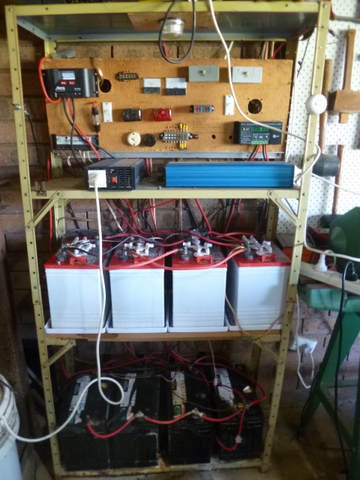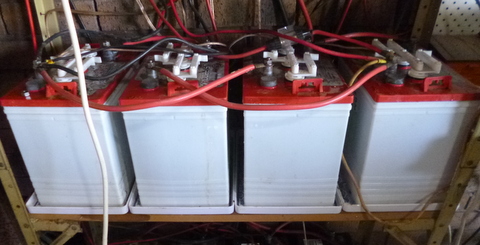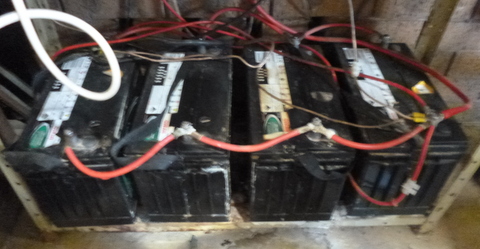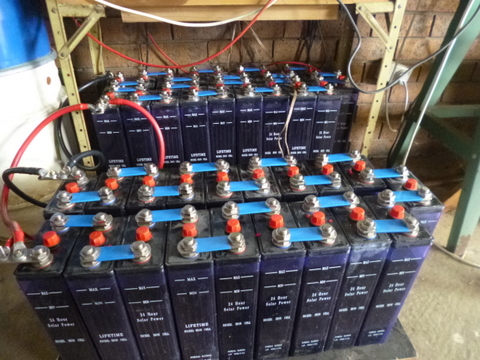Our Off Grid Adventure - Batteries
Created: 2017-02-12 03:10:24
When I first started out putting our system together almost 35 years ago, I used lead acid batteries. That is to say the plates were made out of lead, submerged in an electrolyte solution of dilute sulphuric acid.
My first batteries were obtained in 1983 and they were a pair of 138 amp hour reconditioned second hand truck batteries and they served me well for 4 years, but they were not deep cycle. In 1987 I was offered 8 x 90 amp hour deep cycle batteries ex telecom, standby batteries out of a telephone exchange from a friend of mine. They could have been in the exchange for ten years, and my friend had them under his house for five years, by the time I recycled them 13 years later they wouldn’t carry a charge in a bucket but I got pretty good use out of them.
In 2000 I inherited some money about the same time that the batteries shuffled off their mortal coils and used some of it to buy 4 x 6 volt 220 amphour deep cycle batteries. They are American – (US2200 made by US Batteries) - generally I prefer to buy Australian but they were by far the best price per amphour that I could get. This gave me 440 amphours of storage, but I got greedy and put on another bank of 4 of the same batteries. The original bank bit the dust I replaced them with (theoretically) larger amp hour low maintenance 12 volt batteries but they were never as good as the 6 volt batteries and were the set referred to in the Overview which was decommissioned and recycled.
The second set is still working well and is in the system (for the moment at least) to power the lights. They are currently charged by a small battery charger plugged into the main off-grid system. We do have a DC to DC converter in place which will convert 24VDC to 12VDC so that I can power the lights from the larger system when the batteries fail or the battery charger snuffs it.
The two battery banks for the off grid system are each composed of 19 x 1.2 volt 100 amp hour nickel iron batteries. The batteries in each bank are connected in series to provide 24 volts and then the two banks are connected in parallel to double our storage capacity. But the issue is that the original system was designed around 12 volt lead acid batteries, whereas the new system is set up to be based on 24 volt nickel iron batteries. So, why change?
In Terms of Voltage
The change in voltage is all about current draw. To power the lights meant we were drawing somewhat less than 100 watts at 12 volts (or <8.3 amps) and so the wiring had to reflect that. The larger number of amps, the thicker the wiring needed to be to withstand the current otherwise the wiring could overheat and cause a fire. Another contributing factor was I wanted to be able to use comparatively cheap and readily available 12 volt technology like fans, radios, pumps etc directly without having to go through any extra electronics.
It is a general rule of thumb that you should not have a continuous current draw from your system in excess of 100 amps. While my inverter is oversized at 3000 watts, my usual draw is < 500 watts (42 amps at 12 volts or 21 amps at 24 volts) but I can draw 1500 to 2000 watts over time when we are using the microwave, sandwich press, vacuum cleaner or washing machine. This will result in a draw of up to 167 amps at 12 volts but only 83 amps at 24 volts, hence we designed our system to run on 24 volts. To design a system it is a good thing to start by looking at your projected draw in terms of amperage then work backwards.
In Terms of Batteries
I know lead acid batteries. I have talked, read and experienced them and that familiarity meant that was the technology I turned to first, but there have been some new (and old) technologies becoming more available lately. The things I learned from working with lead acid batteries were that –
- They use sulphuric acid solution as the electrolyte and some WILL leak during charging. So make sure that you have something to catch it in (plastic trays under batteries etc), that it can’t come into contact with metal components like steel shelving and that you wear acid resistant clothing when working with them. I have not increased my popularity in my household by getting large acid holes in new shirts, jeans etc.
- Deep Cycle does not mean DEEP CYCLE – to make sense of this you need to understand that I thought that you could discharge a 12 volt deep cycle battery down to ohhh, I dunno…….9 volts? When I did this I found it reduced the life of the battery bank significantly (ie they got less than half normal service life). It seems that lead acid batteries of the type used in cars are designed to start the car then run back up to full charge straight away. Deep cycle batteries can be run down to 12.0 volts, but the more they cycle down this low the shorter their service life.
- The reverse is also true. If you overcharge the batteries their service life will be drastically reduced as well, so it is really important to have a good quality battery charge controller to prevent this happening. This is important regardless of the amount of charge going into the batteries, even if it is just a few amps trickle charge.
- The best possible performance you can expect from your batteries ie how much charge they will store, will be the very first time you hook them up. After that it is a (very) slow decline to where in 8 to 10 years, even if you treat them well, they won’t carry a charge in the proverbial bucket. If you don’t treat them well, as referenced above, it will be a lot shorter time than that.
Nickel iron batteries are new to me, but I am learning quickly and what I have learned is –
- They use potassium hydroxide solution as the electrolyte. This is nowhere near as rough on clothing or steel parts as sulphuric acid is, and there is no external leakage from the batteries, so your chances of coming in contact with it are reduced considerably. If you are buying your batteries dry and making up your own electrolyte, please be aware that potassium hydroxide solution is more hazardous to the eyes than even sulphuric acid is – so PLEASE wear chemical goggles and/or a face shield!
- Deep cycle means DEEP CYCLE! My 24 volt banks of batteries can be run down to a bit above 19 volts and will still be OK the very next day when the sun comes up to start charging them again.
- Damn these batteries are robust! You can charge them up to 30+ volts without damaging them too.
- When you connect your batteries up and use them to power something, and you keep an eye on battery voltage (as you should) you may be shocked (as I was) to find that initially they hold charge like a sieve holds water. DO NOT be alarmed! This is the way this type of battery works and may take a month or more to bed in and hold a full charge.
Another thing in favour of nickel iron is that they have a projected life that may be 20 or 30 years and I am aware of one set that is still going after 50+ years. So this set will see me out!
My problems mostly stemmed from thinking of the nickel iron batteries in terms of lead acid batteries, but in some aspects (as discussed above) are totally different animals. So while I thought I had a lack of storage capacity, I actually needed more generation capacity.
The big hint is – do your research! Don’t take my word, or anybody else’s for that matter, have a look at some of the good info out there on the net, and see how you



